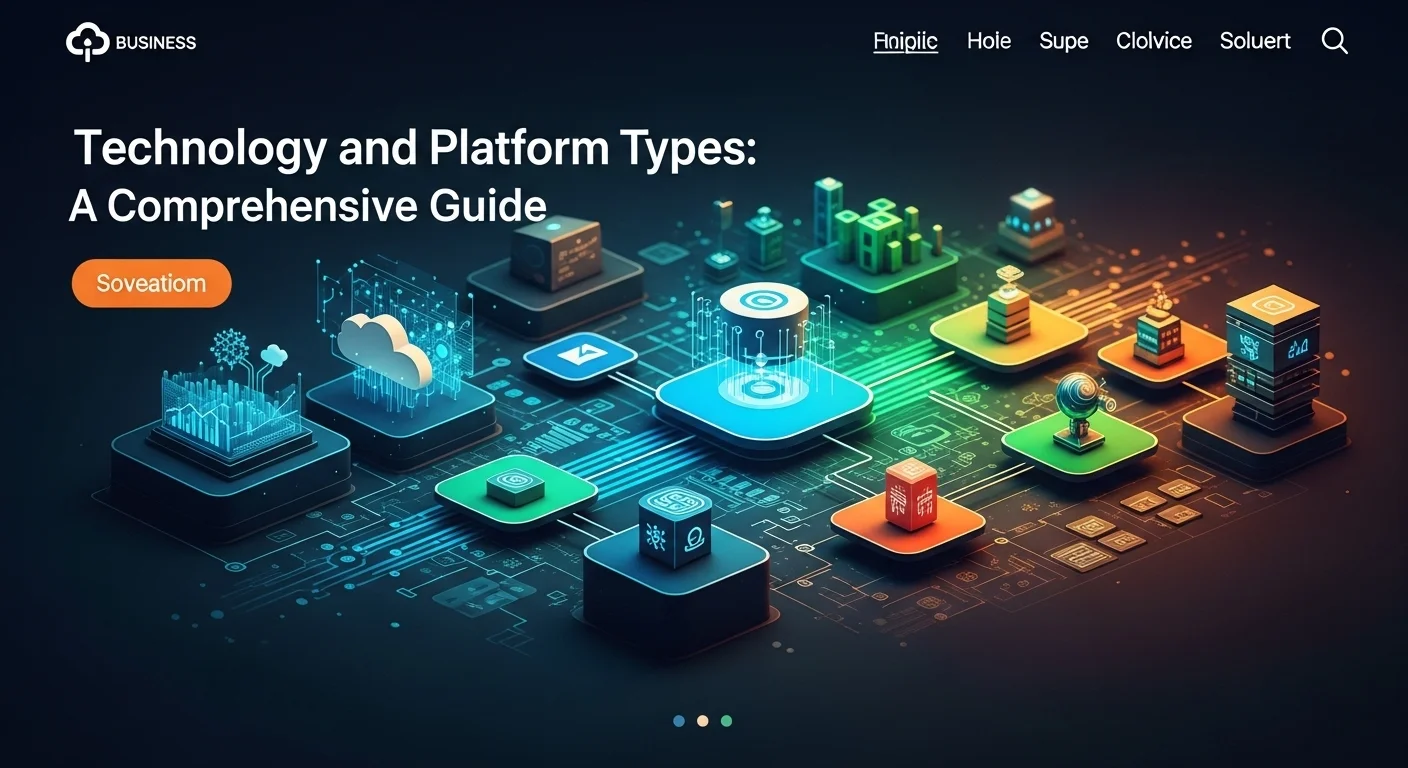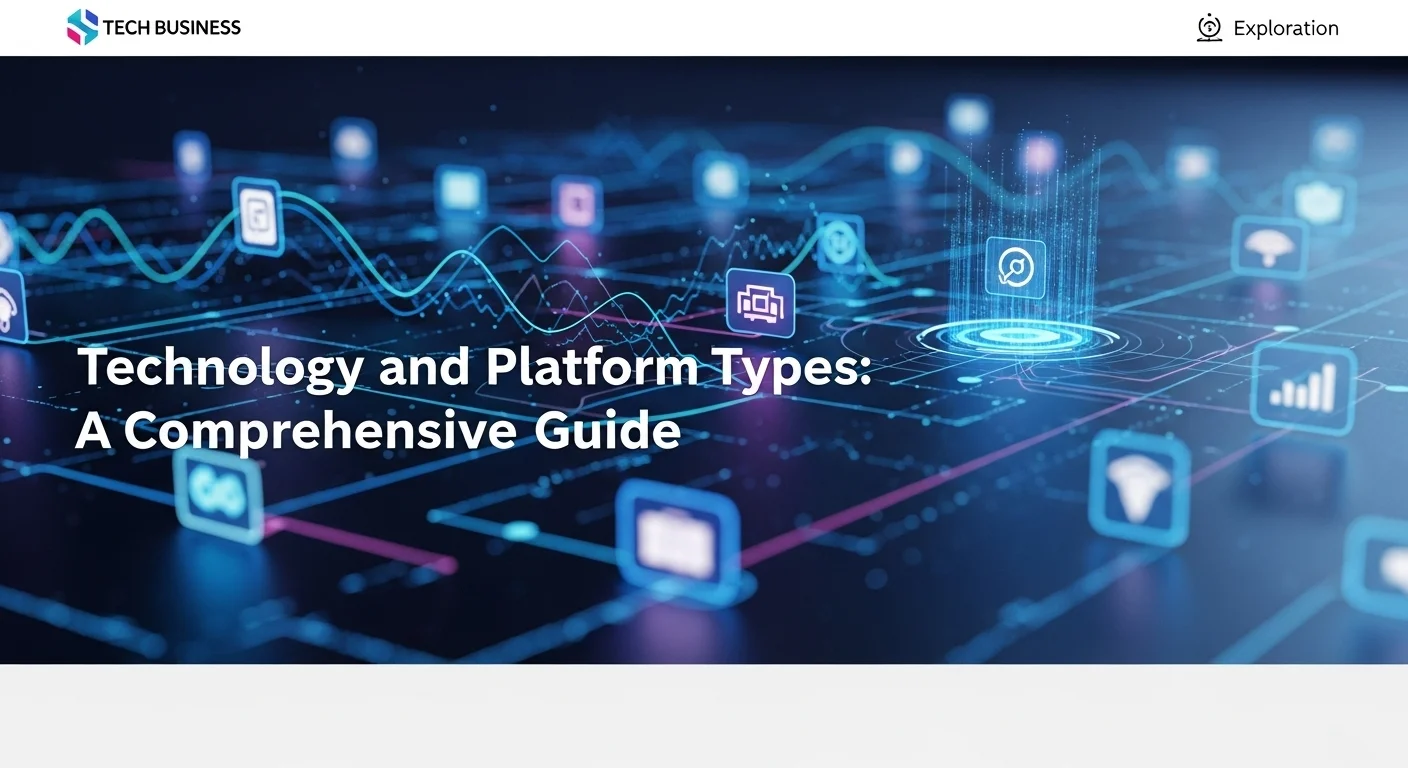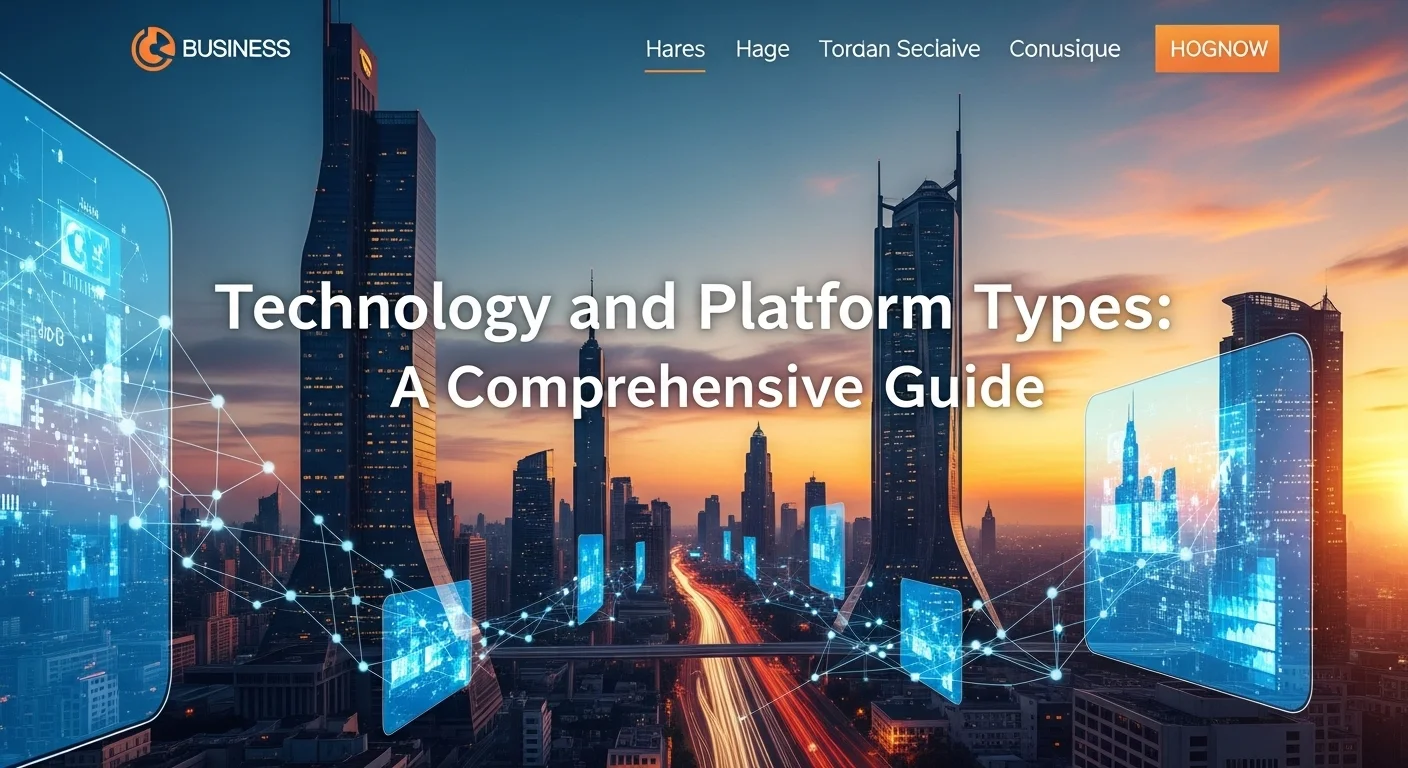Platform Types Explained: A Simple Guide to IaaS, PaaS & SaaS for Your Business

Executive Summary
I've spent over a decade helping businesses, from tiny startups to large enterprises, navigate the often-confusing world of technology. The word 'platform' gets thrown around in almost every meeting, but what does it really mean for your business? In simple terms, a platform is the foundation you build on. In today's world, the most critical foundation is the cloud. This article is my attempt to demystify it all for you. We'll walk through the essential cloud models—Infrastructure as a Service (IaaS), Platform as a Service (PaaS), and Software as a Service (SaaS)—using simple analogies. Choosing the right one isn't just a tech decision; it's a strategic move that affects your budget, your team's speed, and your ability to outmaneuver the competition. My goal is to give you the clarity you need to harness this technology and drive real growth.
Table of Contents
Table of Contents
What Are Tech Platforms, Really?
Let's be honest, the word 'platform' is everywhere in tech, and it can be confusing. At its heart, a platform is just a foundation that other things are built or run on. It provides a set of basic tools and services so that you don't have to start from scratch every single time. Think about the operating system on your phone, like iOS or Android. It's a platform. It handles the camera, the screen, and the internet connection, so app developers can just focus on creating their cool apps. Without these platforms, building anything in technology would be incredibly slow and expensive. They are the unsung heroes that power our digital world, from social media sites like Facebook to e-commerce giants like Amazon.
You interact with different platforms every day. Your computer's operating system (Windows or macOS), social networks (LinkedIn, Twitter), and even online marketplaces (Shopify, Etsy) are all types of platforms. Each one is designed to make a specific task easier, whether it's running software, connecting with people, or selling products. They provide the structure, so we can focus on the creativity and the business side of things. In my experience, the moment a business truly grasps how to leverage the right platforms is the moment it starts to scale effectively.
But in the last decade, one category of platforms has completely changed the game: cloud computing platforms. The cloud has transformed how we work, allowing anyone with an internet connection to access immense computing power. Instead of buying and managing massive, expensive servers in your office closet, you can now 'rent' them from providers like Amazon, Microsoft, or Google. This shift has leveled the playing field, giving small businesses the same powerful tools that were once only available to corporate giants. Understanding the different cloud models isn't just for techies anymore; it's essential knowledge for any business leader looking to innovate and stay competitive.
The Big Three: Breaking Down Cloud Platform Types
When you hear people talk about 'the cloud,' they're usually referring to one of three main service models. Getting these straight is the key to making smart decisions. I love using a simple real estate analogy to explain them: IaaS, PaaS, and SaaS. Each offers a different level of control and convenience, just like choosing where to live.
1. Infrastructure as a Service (IaaS): Your Digital Land
IaaS is the most fundamental cloud service. Imagine you're leasing a plot of land with all the utilities (water, electricity) already hooked up. The provider gives you the basic infrastructure—servers, storage, networking—but you're in charge of everything else. You have to build the house (install the operating system), furnish it (load your applications and data), and maintain it. This model gives you the most flexibility and control. It's perfect for companies with very specific technical needs or those who want to migrate existing systems to the cloud without rebuilding them. I've worked with clients who need this level of control for compliance reasons or for running complex, custom software. Top providers here are Amazon Web Services (AWS), Microsoft Azure, and Google Cloud Platform (GCP).
2. Platform as a Service (PaaS): Your Ready-to-Use Workshop
PaaS takes things a step further. This is like renting a fully equipped workshop. The building is there, the workbenches are set up, and all the tools (like the operating system, development tools, and database systems) are provided and maintained for you. All you have to do is show up and start building your product. For software developers, this is a dream. They can focus purely on writing code and creating amazing applications without ever worrying about server maintenance or software updates. I remember my first startup project; we used a PaaS called Heroku, and it was a game-changer. It let our tiny team focus on building our product instead of wrestling with servers. It dramatically speeds up development, making it a fantastic choice for teams that want to build and launch custom apps fast. AWS Elastic Beanstalk and Google App Engine are other popular examples.
3. Software as a Service (SaaS): Your Fully-Furnished Apartment
SaaS is the model you're probably most familiar with, even if you don't realize it. This is like renting a fully furnished, serviced apartment. You don't own the building or the furniture; you just pay a monthly fee to live there and use everything. The landlord (the provider) handles all the maintenance, repairs, and cleaning. In the tech world, SaaS means you access software over the internet on a subscription basis. You don't install anything; you just log in through your web browser. Think of Google Workspace (Gmail, Docs), Microsoft 365, or Salesforce. The provider manages everything behind the scenes. This is the ultimate convenience model, perfect for businesses that need a ready-made solution for a specific task, like email, accounting, or customer management, with zero technical overhead.
By offloading all this technical heavy lifting, businesses can pour their time and money into what truly matters: innovating and serving their customers. Choosing the right mix of these cloud services allows you to tailor your technology stack perfectly to your business goals, making your company more agile and powerful than ever before.

A Deeper Look: How Cloud Platforms Work for Your Business
Truly understanding the different cloud platform types is more than just a tech trivia—it's a core business skill in today's digital economy. Making the right choice can slash costs, boost your team's productivity, and give you the agility to pounce on new opportunities. This guide will take you deeper into the 'how' and 'why' of cloud platforms, comparing the big three—IaaS, PaaS, and SaaS—to help you build a winning strategy.
The Tech Behind the Scenes: Architectures and Top Players
To make a smart choice, it helps to peek under the hood. The differences between these models are all about what you control versus what the provider manages for you.
Infrastructure as a Service (IaaS) - The Digital Foundation:
With IaaS, you're essentially renting the raw building blocks of a data center. The provider handles the physical servers and virtualization, but you get full control over the virtual machines (VMs). You can install any operating system you want and run any software. It's like being the architect of your own digital space.
Key Components You Control:
- Compute: Virtual machines are your servers. You can pick from a huge menu of options, from small, cheap ones to massive powerhouses with specialized GPUs for heavy-duty tasks.
- Storage: You get different types of storage, like object storage (e.g., AWS S3) for files and media, and block storage (e.g., Azure Disk Storage) that acts as the hard drive for your VMs.
- Networking: You can build your own private, isolated networks in the cloud, set up firewalls, and use load balancers to distribute traffic to your applications.
Leading Providers: Amazon Web Services (AWS), Microsoft Azure, and Google Cloud Platform (GCP) are the titans of IaaS. My advice? Your choice often depends on your team's existing skills, your budget, and whether you need specific tools that one provider does better than others.
Platform as a Service (PaaS) - The Developer's Accelerator:
PaaS is all about developer productivity. It handles the boring, repetitive parts of setting up an environment, like managing the operating system, security patches, and middleware. Your developers just bring their code, and the platform does the rest.
Key Components the Provider Manages:
- Application Runtimes: The platform has environments ready to go for popular languages like Python, Java, Node.js, and more.
- Middleware: Common services like databases, messaging systems, and caching are built-in and managed for you.
- Development Tools: PaaS offerings often integrate with tools for version control (like Git) and automated deployment (CI/CD), streamlining the entire development process.
Leading Providers: Heroku is famous for its beautiful simplicity and is a developer favorite. AWS Elastic Beanstalk and Google App Engine are powerful options that leverage their respective parent company's massive infrastructure.
Software as a Service (SaaS) - The End-User Solution:
From a technical standpoint, SaaS is the simplest for the user. It's a finished product. The provider manages absolutely everything—the servers, the operating system, the code, the updates. The architecture is usually 'multi-tenant,' which means multiple customers share a single instance of the software. This efficiency is what allows providers to offer powerful software at a low monthly cost.
Key Characteristics:
- Web-Based Access: Just open your browser and log in. No installation required.
- Automatic Updates: You're always on the latest, greatest, and most secure version without lifting a finger.
- Subscription Model: You pay a predictable recurring fee, which is great for budgeting.
Leading Providers: You use them every day. Salesforce for CRM, Microsoft 365 for productivity, and Google Workspace for collaboration are perfect examples.
Smart Business Moves: Choosing Your Platform Strategy
The right choice depends entirely on your business goals.
1. Align Platform with Business Need:
- For Startups and Agile Teams: I almost always recommend starting with PaaS and SaaS. They keep initial costs low and let a small team focus on building the product, not managing infrastructure. A common stack I've seen succeed is Heroku (PaaS) for the app and Google Workspace (SaaS) for day-to-day operations.
- For Established Enterprises: It's usually a mix. A large company might use SaaS for standard departments like HR and finance (e.g., Workday), PaaS for developing new customer-facing apps, and IaaS for specialized workloads or lifting-and-shifting legacy systems to the cloud. This is often called a 'hybrid cloud' or 'multi-cloud' strategy.
- For Highly Regulated Industries: Companies in finance or healthcare often lean towards IaaS because it offers the fine-grained control needed to meet strict compliance and security rules. However, many PaaS and SaaS providers now offer compliant versions of their services (e.g., HIPAA-compliant).
2. Look at the Total Cost of Ownership (TCO):
Don't just compare the monthly subscription fees. With IaaS, you also have to pay for the salaries of the engineers who will manage it all. That cost is much lower with PaaS and almost zero with SaaS. You have to weigh the flexibility and control of IaaS against its higher operational cost. It's a classic trade-off: control vs. convenience.
3. Don't Be Afraid to Mix and Match (Hybrid & Multi-Cloud):
Very few companies are 100% on one provider or one model. A hybrid cloud strategy means mixing your own private servers with public cloud services. A multi-cloud strategy means using services from multiple providers, like AWS for storage and Google Cloud for its machine learning tools. This helps you avoid being locked into one vendor and lets you pick the best tool for each job.
At a Glance: IaaS vs. PaaS vs. SaaS
Here’s a simple chart to pull it all together:
| Feature | IaaS (Infrastructure as a Service) | PaaS (Platform as a Service) | SaaS (Software as a Service) |
|---|---|---|---|
| Analogy | Leasing Land | Renting a Fully-Equipped Workshop | Renting a Furnished Apartment |
| You Manage | Applications, Data, Runtime, Middleware, OS | Applications & Data | Nothing (Just use the software) |
| Provider Manages | Servers, Storage, Networking, Virtualization | Everything in IaaS + OS, Middleware, Runtime | Everything |
| Best For | Total infrastructure control, custom systems | Rapid custom application development | Ready-to-use business software (email, CRM) |
| Flexibility | Very High | Medium | Low |
| Your Effort | High | Medium | Very Low |
| Examples | AWS EC2, Azure VMs, Google Compute Engine | Heroku, AWS Elastic Beanstalk, Google App Engine | Salesforce, Microsoft 365, Dropbox |
By understanding these business and technical trade-offs, you can move from simply 'using the cloud' to building a smart, intentional technology strategy that will serve as a powerful engine for your company's future.

Pro Tips for Mastering Your Tech Platforms
Choosing the right platform is just the first step. The real magic happens when you learn how to manage and optimize it effectively over time. This is where you can gain a serious competitive advantage. Over the years, I've seen companies thrive—and others stumble—based on how they approach their cloud operations. Here are some of the most important strategies and best practices I've learned for getting the most out of your technology stack.
Everyday Best Practices for Cloud Management
Whether you're using IaaS, PaaS, or SaaS, these habits will help you stay secure, control costs, and run a tight ship.
1. Set Up Strong Cloud Governance from Day One:
I've seen companies get hit with surprise five-figure cloud bills. Don't let that be you. Cloud governance isn't just bureaucracy; it's about maintaining control. Your framework should include:
- Cost Management: Use the provider's built-in tools (like AWS Cost Explorer or Azure Cost Management) to see where your money is going. Tag all your resources so you can assign costs to specific projects or teams. Set up budget alerts to get notified before you overspend. And please, regularly shut down resources you aren't using!
- Security and Compliance: Remember the 'shared responsibility' model. The provider secures the cloud, but you secure what's *in* the cloud. Use Identity and Access Management (IAM) to give people only the permissions they absolutely need (this is called the 'principle of least privilege'). Encrypt your sensitive data. It’s a simple step that makes a huge difference.
- Access Control: Be strict about who can create or delete resources. Always, always use multi-factor authentication (MFA) on your administrative accounts. It's one of the single most effective security measures you can take.
2. Automate Everything You Can (Infrastructure as Code):
Manually clicking around a web console to set up servers is slow, easy to mess up, and impossible to do consistently at scale. The modern approach is Infrastructure as Code (IaC), using tools like Terraform or AWS CloudFormation. You write definition files that describe your entire setup. The benefits are massive: your infrastructure is repeatable, documented in code, and can be version-controlled just like your application. This reduces human error and frees up your team for more important work.
3. Have a Smart Data Strategy:
Your data is one of your most valuable assets. Treat it that way. Your plan should cover:
- Backup and Disaster Recovery (DR): The cloud is reliable, but it's not infallible. You must have a plan. Regularly back up your data and, more importantly, *test* that you can restore it. A backup you've never tested is just a prayer. Use different geographic regions to create a DR plan so a major outage in one area doesn't take your whole business offline.
- Data Tiering for Cost Savings: Not all data needs the same level of access. Store critical, frequently used data on high-performance storage. Move older, archival data to much cheaper 'cold' storage tiers like AWS Glacier. This is an easy way to save a lot of money.
- Data Location Matters: Be aware of laws like GDPR in Europe that dictate where customer data can be stored. Choose your cloud regions carefully to stay compliant.
How to Avoid Getting Trapped by One Vendor
Vendor lock-in is a real concern. It's when you become so dependent on one provider that moving would be prohibitively expensive or difficult. You can't eliminate it completely, but you can manage the risk:
- Use Open-Source Technologies: When possible, choose services based on open-source software like PostgreSQL or MySQL. This makes it much easier to migrate to another provider's compatible service if you ever need to.
- Containerize Your Applications: This is a big one. Technologies like Docker and Kubernetes allow you to package your application and its dependencies into a portable 'container.' This container can run on any major cloud provider's Kubernetes service (like AWS EKS, Google GKE, or Azure AKS). This is probably the most powerful strategy today for maintaining flexibility.
- Build an Abstraction Layer: For more advanced teams, you can design your application to be platform-agnostic by creating a 'middle layer' in your code that separates your business logic from the specific cloud services it calls.
What's Next? The Future of Tech Platforms
The world of platforms is always moving. Here’s a quick look at what’s on the horizon:
1. Serverless Computing (FaaS):
This is the next evolution of PaaS. With Serverless, or Function as a Service (FaaS), you don't even think about servers or containers. You just write small pieces of code ('functions') that run in response to events. The provider handles everything else, and you only pay for the split-seconds your code is actually running. Services like AWS Lambda and Azure Functions are pioneering this and it's changing how we build applications, especially for workloads with spiky or unpredictable traffic.
2. AI and Machine Learning as a Service:
The major cloud providers are in an arms race to make AI and Machine Learning (ML) easy to use. Platforms like Amazon SageMaker and Google AI Platform offer everything from pre-trained models for common tasks (like analyzing text or recognizing images) to fully managed environments for building your own custom models. This is making AI accessible to every business, not just those with huge research departments.
3. Edge Computing:
For IoT devices like smart factory sensors or autonomous cars, sending data all the way to the cloud and back is too slow. Edge computing brings the processing power closer to where the data is created. Platforms like AWS Outposts and Azure Stack allow you to run cloud services right in your own facility or at the 'edge' of the network, enabling real-time applications that weren't possible before.
By staying on top of these practices and trends, you can build a technology strategy that not only works for you today but also sets you up for success tomorrow. The journey is one of constant learning and adapting. For a fantastic deep-dive into cloud architecture best practices, I always recommend the AWS Well-Architected Framework; its principles are valuable no matter which provider you choose.
Expert Reviews & Testimonials
Sarah Johnson, Business Owner ⭐⭐⭐
This was a good overview, but as a small business owner, I was hoping for more step-by-step examples of how to apply this. The concepts are clear, though.
Mike Chen, IT Consultant ⭐⭐⭐⭐
Solid guide to platform types. Cleared up a few things for me. A little simplification on the technical deep-dive would make it perfect for my clients.
Emma Davis, Tech Expert ⭐⭐⭐⭐⭐
Excellent article! Very comprehensive on Platform Types. It helped me a lot for my specialization and I understood everything perfectly.



